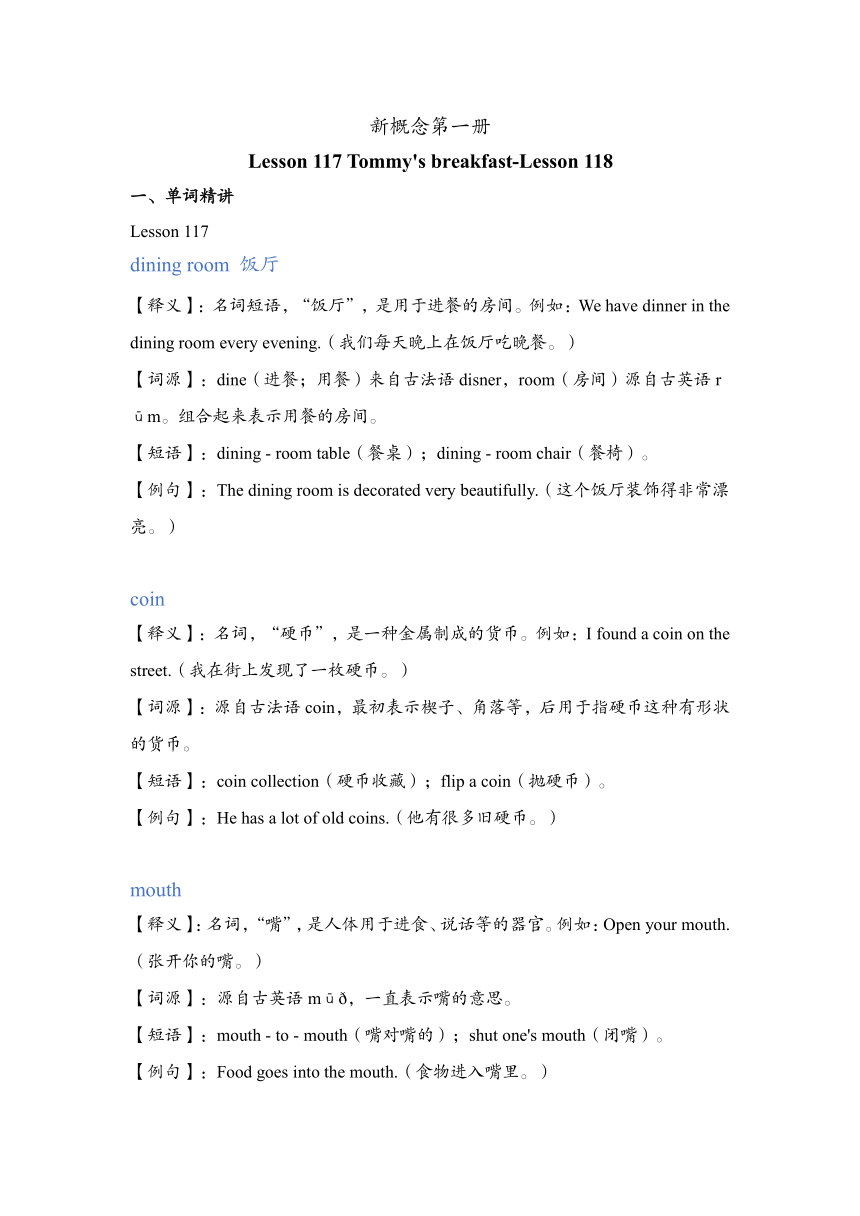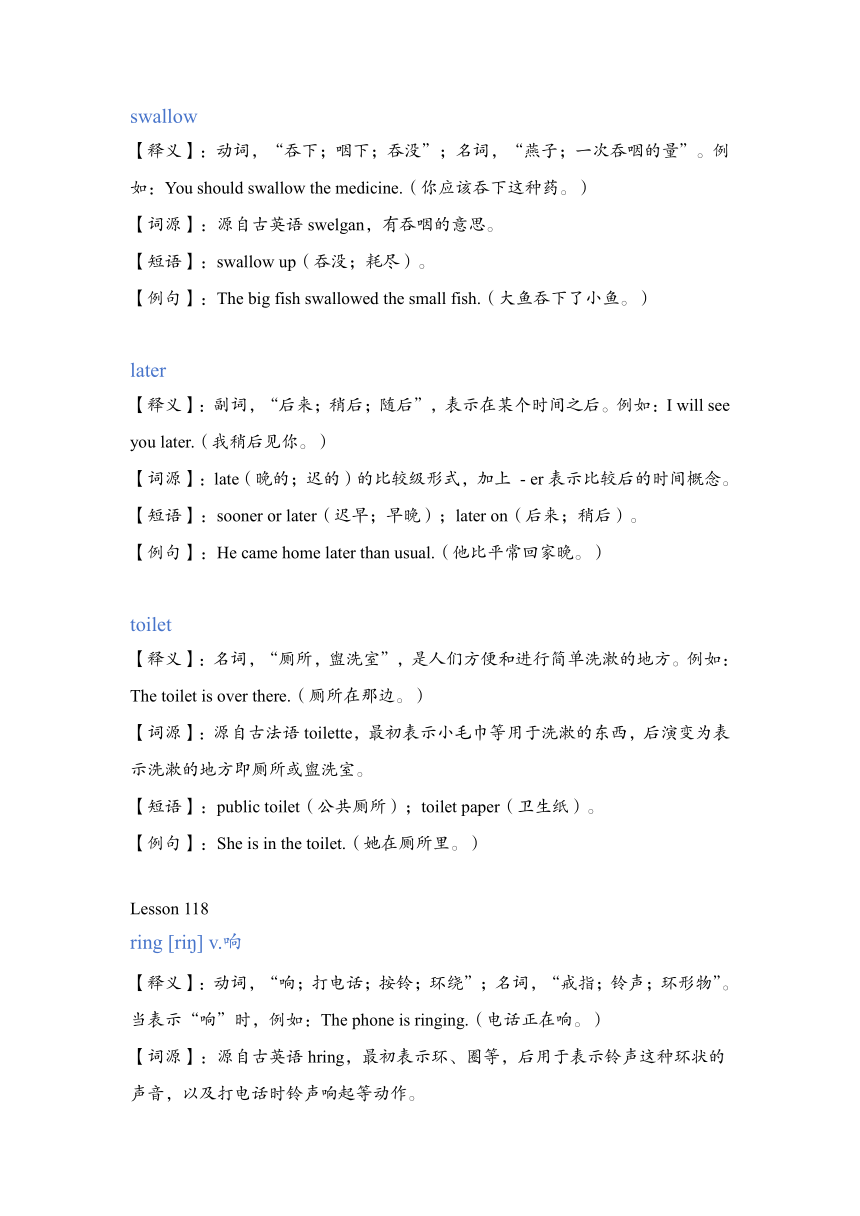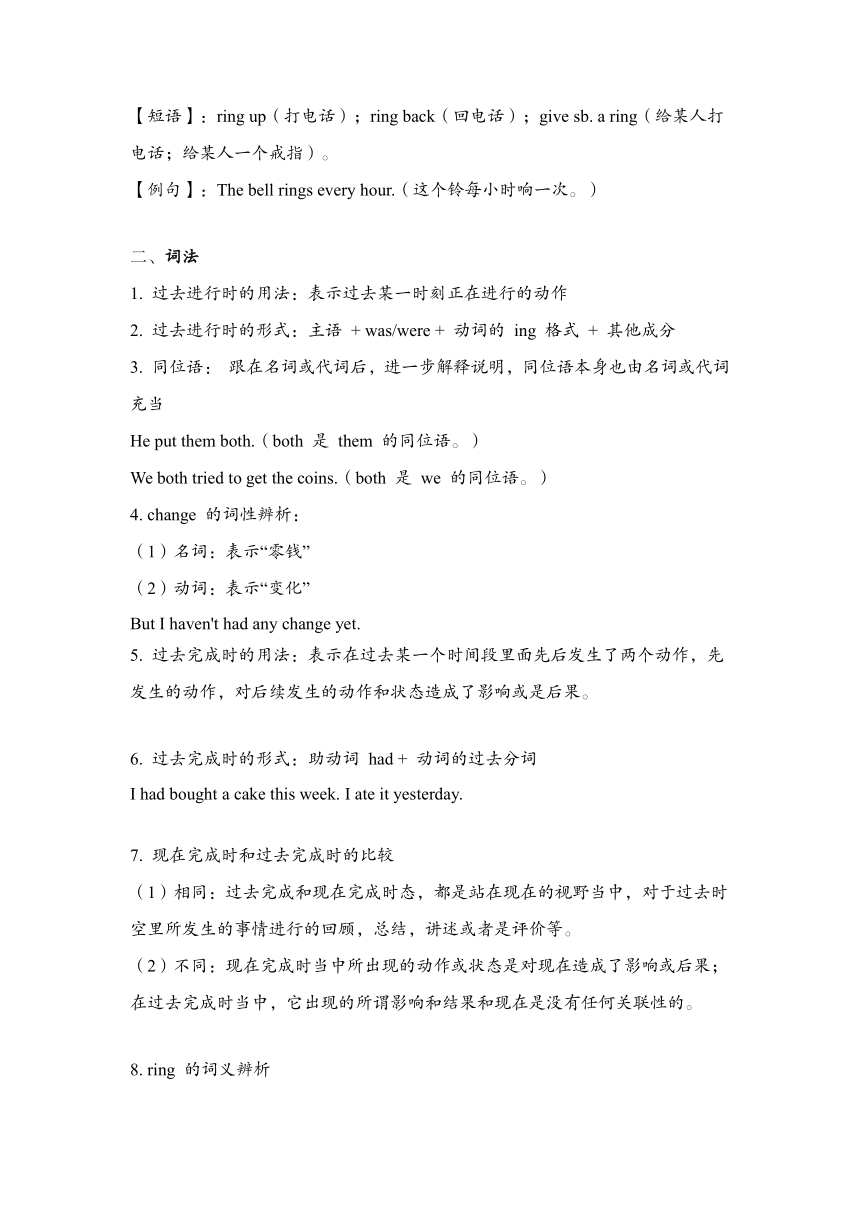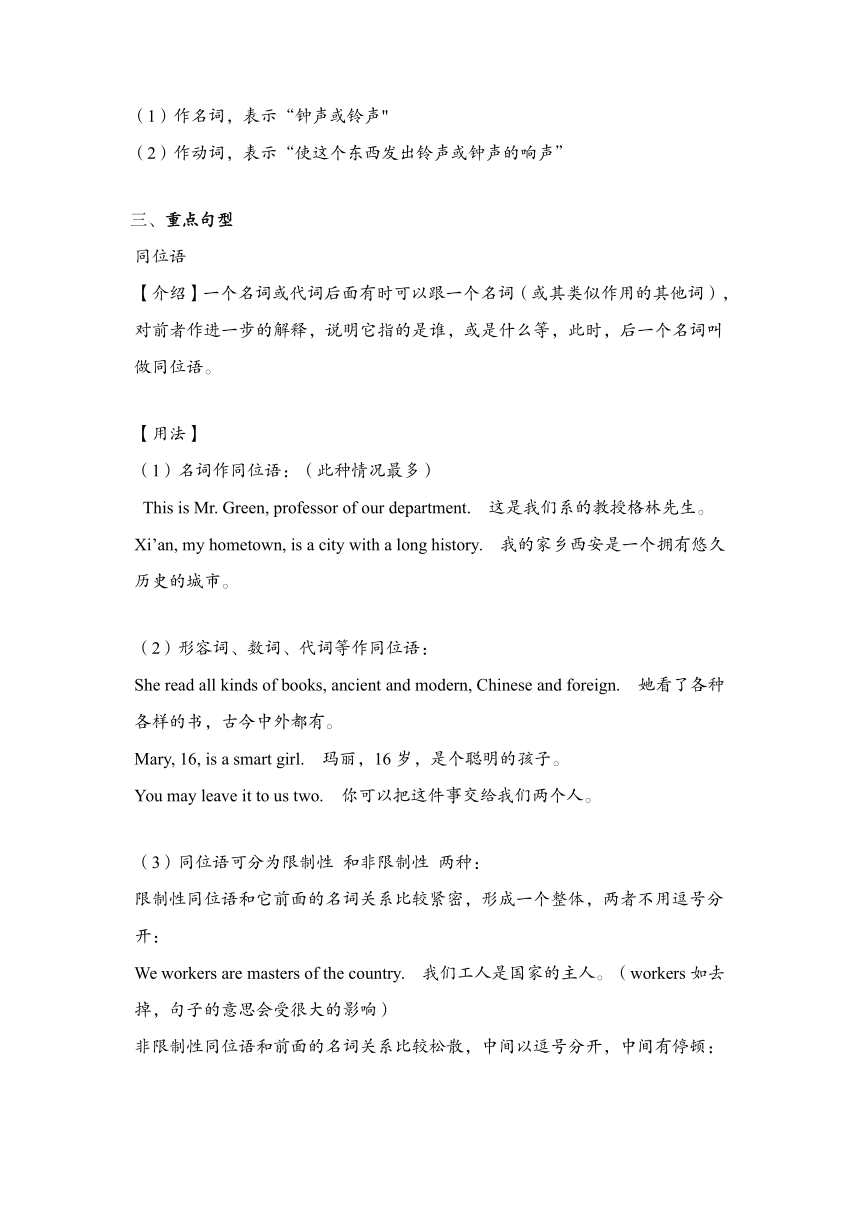新概念第一册Lesson 117 Tommy's breakfast-Lesson 118讲义
文档属性
| 名称 | 新概念第一册Lesson 117 Tommy's breakfast-Lesson 118讲义 |  | |
| 格式 | docx | ||
| 文件大小 | 144.8KB | ||
| 资源类型 | 教案 | ||
| 版本资源 | 新概念英语 | ||
| 科目 | 英语 | ||
| 更新时间 | 2024-12-03 22:59:27 | ||
图片预览




文档简介
新概念第一册
Lesson 117 Tommy's breakfast-Lesson 118
单词精讲
Lesson 117
dining room 饭厅
【释义】:名词短语,“饭厅”,是用于进餐的房间。例如:We have dinner in the dining room every evening.(我们每天晚上在饭厅吃晚餐。)
【词源】:dine(进餐;用餐)来自古法语disner,room(房间)源自古英语rūm。组合起来表示用餐的房间。
【短语】:dining - room table(餐桌);dining - room chair(餐椅)。
【例句】:The dining room is decorated very beautifully.(这个饭厅装饰得非常漂亮。)
coin
【释义】:名词,“硬币”,是一种金属制成的货币。例如:I found a coin on the street.(我在街上发现了一枚硬币。)
【词源】:源自古法语coin,最初表示楔子、角落等,后用于指硬币这种有形状的货币。
【短语】:coin collection(硬币收藏);flip a coin(抛硬币)。
【例句】:He has a lot of old coins.(他有很多旧硬币。)
mouth
【释义】:名词,“嘴”,是人体用于进食、说话等的器官。例如:Open your mouth.(张开你的嘴。)
【词源】:源自古英语mū ,一直表示嘴的意思。
【短语】:mouth - to - mouth(嘴对嘴的);shut one's mouth(闭嘴)。
【例句】:Food goes into the mouth.(食物进入嘴里。)
swallow
【释义】:动词,“吞下;咽下;吞没”;名词,“燕子;一次吞咽的量”。例如:You should swallow the medicine.(你应该吞下这种药。)
【词源】:源自古英语swelgan,有吞咽的意思。
【短语】:swallow up(吞没;耗尽)。
【例句】:The big fish swallowed the small fish.(大鱼吞下了小鱼。)
later
【释义】:副词,“后来;稍后;随后”,表示在某个时间之后。例如:I will see you later.(我稍后见你。)
【词源】:late(晚的;迟的)的比较级形式,加上 - er表示比较后的时间概念。
【短语】:sooner or later(迟早;早晚);later on(后来;稍后)。
【例句】:He came home later than usual.(他比平常回家晚。)
toilet
【释义】:名词,“厕所,盥洗室”,是人们方便和进行简单洗漱的地方。例如:The toilet is over there.(厕所在那边。)
【词源】:源自古法语toilette,最初表示小毛巾等用于洗漱的东西,后演变为表示洗漱的地方即厕所或盥洗室。
【短语】:public toilet(公共厕所);toilet paper(卫生纸)。
【例句】:She is in the toilet.(她在厕所里。)
Lesson 118
ring [ri ] v.响
【释义】:动词,“响;打电话;按铃;环绕”;名词,“戒指;铃声;环形物”。当表示“响”时,例如:The phone is ringing.(电话正在响。)
【词源】:源自古英语hring,最初表示环、圈等,后用于表示铃声这种环状的声音,以及打电话时铃声响起等动作。
【短语】:ring up(打电话);ring back(回电话);give sb. a ring(给某人打电话;给某人一个戒指)。
【例句】:The bell rings every hour.(这个铃每小时响一次。)
词法
1. 过去进行时的用法:表示过去某一时刻正在进行的动作
2. 过去进行时的形式:主语 + was/were + 动词的 ing 格式 + 其他成分
3. 同位语: 跟在名词或代词后,进一步解释说明,同位语本身也由名词或代词充当
He put them both.(both 是 them 的同位语。)
We both tried to get the coins.(both 是 we 的同位语。)
4. change 的词性辨析:
(1)名词:表示“零钱”
(2)动词:表示“变化”
But I haven't had any change yet.
5. 过去完成时的用法:表示在过去某一个时间段里面先后发生了两个动作,先发生的动作,对后续发生的动作和状态造成了影响或是后果。
6. 过去完成时的形式:助动词 had + 动词的过去分词
I had bought a cake this week. I ate it yesterday.
7. 现在完成时和过去完成时的比较
(1)相同:过去完成和现在完成时态,都是站在现在的视野当中,对于过去时空里所发生的事情进行的回顾,总结,讲述或者是评价等。
(2)不同:现在完成时当中所出现的动作或状态是对现在造成了影响或后果;在过去完成时当中,它出现的所谓影响和结果和现在是没有任何关联性的。
8. ring 的词义辨析
(1)作名词,表示“钟声或铃声"
(2)作动词,表示“使这个东西发出铃声或钟声的响声”
重点句型
同位语
【介绍】一个名词或代词后面有时可以跟一个名词(或其类似作用的其他词),对前者作进一步的解释,说明它指的是谁,或是什么等,此时,后一个名词叫做同位语。
【用法】
(1)名词作同位语:(此种情况最多)
This is Mr. Green, professor of our department. 这是我们系的教授格林先生。
Xi’an, my hometown, is a city with a long history. 我的家乡西安是一个拥有悠久历史的城市。
(2)形容词、数词、代词等作同位语:
She read all kinds of books, ancient and modern, Chinese and foreign. 她看了各种各样的书,古今中外都有。
Mary, 16, is a smart girl. 玛丽,16岁,是个聪明的孩子。
You may leave it to us two. 你可以把这件事交给我们两个人。
(3)同位语可分为限制性 和非限制性 两种:
限制性同位语和它前面的名词关系比较紧密,形成一个整体,两者不用逗号分开:
We workers are masters of the country. 我们工人是国家的主人。(workers如去掉,句子的意思会受很大的影响)
非限制性同位语和前面的名词关系比较松散,中间以逗号分开,中间有停顿:
Tom, my best friend, will come to see me this evening. 汤姆,我最好的朋友,今天晚上要来看我。(同位语去掉,句子还能成立。)
过去进行时
【介绍】
1 在过去某个特定的时间正在进行或发生的动作。
2 当过去的一个动作发生的时候另外一个动作正在进行
结构:主语+ was(were)+ doing(动词的现在分词)
【用法】
(1)过去进行时表示在某一段时间内进行或发生的动作。比如:
We were watching TV from seven to nine last night. 昨晚七点到九点的时候我们在看电视。
What was he researching all day last Sunday 上周日他一整天都在研究什么?
(2)过去进行时可以表示在过去某个时间点发生的事情。时间点可以用介词短语、副词或从句来表示。比如:
What was she doing at nine o’clock yesterday?昨天晚上九点她在做什么?
He was decorating his room then. 当时他正在装饰房间。
(3)过去进行时可用在由when, while, (just) as等引导的时间状语从句中。比如:
When I was doing the housework, my husband telephoned me from the office. 当我正在干家务时,我丈夫从办公室打电话给我。
While I was listening to the stereo, my mother came into the room. 我正在听立体声节目时,我母亲进房间了。
Just as she was cleaning her shies, George knocked at the door. 她正在擦鞋时, 乔治敲门了。
While I was cooking the dinner, he was working in the garden. 我做饭时,他正在花园里劳作。
(4)when, while, as的区别:
1 when引导的从句的谓语动词可以是瞬间性的,也可以是延续性的;
when有时表示“就在那时”。
e.g. When she came in, I was eating. 她进来时,我在吃饭。(瞬时动词)
When I lived in the countryside, I used to carry some water for him. 当我住在农村时,我常常为他担水。(延续性的动词)
We were about to leave when he came in. 我们就要离开,就在那时他进来了。
2 While引导的从句的谓语动作必须是延续性的,并强调主句和从句的动作同时发生(或者相对应)。并且while有时还可以表示对比。
e.g. While my wife was reading the newspaper, I was watching TV. 当我妻子读报纸的时候,我在看电视。(was reading是延续性的动词,was reading和was watching同时发生)
I like playing football while you like playing basketball. 我喜欢踢足球,而你喜欢打篮球。(对比)
3 As表示“一边……一边”,“随着……”as引导的动作是延续性的动作,一般用于主句和从句动作同时发生。
e.g. We always sing as we walk. 我们总是边走边唱。(as表示“一边……一边”)
As I grew odder, I know more about life. 随着我年龄的增长,我对生活更加了解。
just as 正当……
I cut myself while I was shaving.
I cut myself badly while I was shaving.
过去完成时
过去某个特定的时间之前动作已经完成。过去两个动作的比较,发生在前面的是过去完成时,后面的是一般过去时。
结构:
主语 + had + 动词的过去分词
I had read five books by the end of last year.
The students had learnt two thousand words by the end of last term.
before, after
Mr.Smith bought a new car after he had sold his old car.
We had had dinner before they arrived.
When I was leaving the house he arrived.
When I was having breakfast, someone knocked at the door.
四、课文精讲
When my husband was going into the dining room this morning, he dropped some coins on the floor.
【译文】今天早晨我丈夫走进饭厅时,把一些硬币掉在地上了。
【用法】1 when引导时间状语从句,前半句为从句,后半句为主句。
2 when引导时间状语从句时,谓语可以是瞬间性动作,也可以是延续性动作。
3 was going是过去进行时的谓语部分,drop sth. + 地点“把……掉在……”.
We looked for them, but we could not find them all.
【译文】我们虽然找了,但没能把它们全部找到。
【用法】1 look for“寻找”,强调找的过程和动作;而find“找到”,强调找的结果。
2 代词all是them的同位语成分。(限制性同位语)
While we were having breakfast, our little boy, Tommy, found two small coins on the floor.
【译文】当我们吃早饭是,我们的儿子小汤米在地上找到了两枚硬币。
【用法】1 while引导时间状语从句时,谓语必须是延续性动作,且常见进行时态。
2 名词Tommy是our little boy的同位语成分。(非限制性同位语)
He put them both in to his mouth.
【译文】他把这两枚硬币全都放进了嘴里。
【用法】1 put sth. into …… 把……放进……,例如:
I put all my books into my bag.
我把我所有的书都放进了包里。
类似短语:put sth. on…… 把……放在……上
2 代词both是them的同位语成分。(限制性同位语)
We both tried to get the coins, but it was too late. Tommy had already swallowed them!
【译文】我们俩都试图把这两枚硬币弄出来,但太迟了。汤米已经把硬币吞了下去。
【用法】1 代词both是we的同位语成分。(限制性同位语)
2 tried是动词try的过去式。try也可用作名词。
try to do sth. “努力、尽力做某事”
try doing sth. “尝试做某事”
try one’s best to do sth. = do one’s best to do sth. “尽某人最大努力做某事”
try on + 衣服 试穿……
try out sth. “试验、试用” try out this idea 试试这个主意
have a try “试一试”,try是名词。
get有“拿到、弄到”之意,此处表示把硬币弄出来。
had swallowed 是过去完成时,结构为had + done。(在119课详述)
过去完成时表示的动作是发生在一个过去时的动作之前。本句中在我们试图把硬币弄出来之前,汤米就已经吞下硬币了。例如:
After they had entered the house,
they went into the dining room.
他们进了房子之后,就去了餐厅。
I didn’t go to bed before I had finished my homework.
我写完作业之后才去睡觉。
Tommy ’s been to the toilet three times this morning, but I haven’t had any change yet!
【译文】今天上午汤米去了3次厕所了,但我还没看到硬币。
【用法】1 has been to与次数连用,表示“去过多少次”
2 change在此处一语双关,既可表示“变化”,也可解释为“零钱”。副词yet用在现在完成时的否定句中构成not……yet,意为“还没”。
Lesson 117 Tommy's breakfast-Lesson 118
单词精讲
Lesson 117
dining room 饭厅
【释义】:名词短语,“饭厅”,是用于进餐的房间。例如:We have dinner in the dining room every evening.(我们每天晚上在饭厅吃晚餐。)
【词源】:dine(进餐;用餐)来自古法语disner,room(房间)源自古英语rūm。组合起来表示用餐的房间。
【短语】:dining - room table(餐桌);dining - room chair(餐椅)。
【例句】:The dining room is decorated very beautifully.(这个饭厅装饰得非常漂亮。)
coin
【释义】:名词,“硬币”,是一种金属制成的货币。例如:I found a coin on the street.(我在街上发现了一枚硬币。)
【词源】:源自古法语coin,最初表示楔子、角落等,后用于指硬币这种有形状的货币。
【短语】:coin collection(硬币收藏);flip a coin(抛硬币)。
【例句】:He has a lot of old coins.(他有很多旧硬币。)
mouth
【释义】:名词,“嘴”,是人体用于进食、说话等的器官。例如:Open your mouth.(张开你的嘴。)
【词源】:源自古英语mū ,一直表示嘴的意思。
【短语】:mouth - to - mouth(嘴对嘴的);shut one's mouth(闭嘴)。
【例句】:Food goes into the mouth.(食物进入嘴里。)
swallow
【释义】:动词,“吞下;咽下;吞没”;名词,“燕子;一次吞咽的量”。例如:You should swallow the medicine.(你应该吞下这种药。)
【词源】:源自古英语swelgan,有吞咽的意思。
【短语】:swallow up(吞没;耗尽)。
【例句】:The big fish swallowed the small fish.(大鱼吞下了小鱼。)
later
【释义】:副词,“后来;稍后;随后”,表示在某个时间之后。例如:I will see you later.(我稍后见你。)
【词源】:late(晚的;迟的)的比较级形式,加上 - er表示比较后的时间概念。
【短语】:sooner or later(迟早;早晚);later on(后来;稍后)。
【例句】:He came home later than usual.(他比平常回家晚。)
toilet
【释义】:名词,“厕所,盥洗室”,是人们方便和进行简单洗漱的地方。例如:The toilet is over there.(厕所在那边。)
【词源】:源自古法语toilette,最初表示小毛巾等用于洗漱的东西,后演变为表示洗漱的地方即厕所或盥洗室。
【短语】:public toilet(公共厕所);toilet paper(卫生纸)。
【例句】:She is in the toilet.(她在厕所里。)
Lesson 118
ring [ri ] v.响
【释义】:动词,“响;打电话;按铃;环绕”;名词,“戒指;铃声;环形物”。当表示“响”时,例如:The phone is ringing.(电话正在响。)
【词源】:源自古英语hring,最初表示环、圈等,后用于表示铃声这种环状的声音,以及打电话时铃声响起等动作。
【短语】:ring up(打电话);ring back(回电话);give sb. a ring(给某人打电话;给某人一个戒指)。
【例句】:The bell rings every hour.(这个铃每小时响一次。)
词法
1. 过去进行时的用法:表示过去某一时刻正在进行的动作
2. 过去进行时的形式:主语 + was/were + 动词的 ing 格式 + 其他成分
3. 同位语: 跟在名词或代词后,进一步解释说明,同位语本身也由名词或代词充当
He put them both.(both 是 them 的同位语。)
We both tried to get the coins.(both 是 we 的同位语。)
4. change 的词性辨析:
(1)名词:表示“零钱”
(2)动词:表示“变化”
But I haven't had any change yet.
5. 过去完成时的用法:表示在过去某一个时间段里面先后发生了两个动作,先发生的动作,对后续发生的动作和状态造成了影响或是后果。
6. 过去完成时的形式:助动词 had + 动词的过去分词
I had bought a cake this week. I ate it yesterday.
7. 现在完成时和过去完成时的比较
(1)相同:过去完成和现在完成时态,都是站在现在的视野当中,对于过去时空里所发生的事情进行的回顾,总结,讲述或者是评价等。
(2)不同:现在完成时当中所出现的动作或状态是对现在造成了影响或后果;在过去完成时当中,它出现的所谓影响和结果和现在是没有任何关联性的。
8. ring 的词义辨析
(1)作名词,表示“钟声或铃声"
(2)作动词,表示“使这个东西发出铃声或钟声的响声”
重点句型
同位语
【介绍】一个名词或代词后面有时可以跟一个名词(或其类似作用的其他词),对前者作进一步的解释,说明它指的是谁,或是什么等,此时,后一个名词叫做同位语。
【用法】
(1)名词作同位语:(此种情况最多)
This is Mr. Green, professor of our department. 这是我们系的教授格林先生。
Xi’an, my hometown, is a city with a long history. 我的家乡西安是一个拥有悠久历史的城市。
(2)形容词、数词、代词等作同位语:
She read all kinds of books, ancient and modern, Chinese and foreign. 她看了各种各样的书,古今中外都有。
Mary, 16, is a smart girl. 玛丽,16岁,是个聪明的孩子。
You may leave it to us two. 你可以把这件事交给我们两个人。
(3)同位语可分为限制性 和非限制性 两种:
限制性同位语和它前面的名词关系比较紧密,形成一个整体,两者不用逗号分开:
We workers are masters of the country. 我们工人是国家的主人。(workers如去掉,句子的意思会受很大的影响)
非限制性同位语和前面的名词关系比较松散,中间以逗号分开,中间有停顿:
Tom, my best friend, will come to see me this evening. 汤姆,我最好的朋友,今天晚上要来看我。(同位语去掉,句子还能成立。)
过去进行时
【介绍】
1 在过去某个特定的时间正在进行或发生的动作。
2 当过去的一个动作发生的时候另外一个动作正在进行
结构:主语+ was(were)+ doing(动词的现在分词)
【用法】
(1)过去进行时表示在某一段时间内进行或发生的动作。比如:
We were watching TV from seven to nine last night. 昨晚七点到九点的时候我们在看电视。
What was he researching all day last Sunday 上周日他一整天都在研究什么?
(2)过去进行时可以表示在过去某个时间点发生的事情。时间点可以用介词短语、副词或从句来表示。比如:
What was she doing at nine o’clock yesterday?昨天晚上九点她在做什么?
He was decorating his room then. 当时他正在装饰房间。
(3)过去进行时可用在由when, while, (just) as等引导的时间状语从句中。比如:
When I was doing the housework, my husband telephoned me from the office. 当我正在干家务时,我丈夫从办公室打电话给我。
While I was listening to the stereo, my mother came into the room. 我正在听立体声节目时,我母亲进房间了。
Just as she was cleaning her shies, George knocked at the door. 她正在擦鞋时, 乔治敲门了。
While I was cooking the dinner, he was working in the garden. 我做饭时,他正在花园里劳作。
(4)when, while, as的区别:
1 when引导的从句的谓语动词可以是瞬间性的,也可以是延续性的;
when有时表示“就在那时”。
e.g. When she came in, I was eating. 她进来时,我在吃饭。(瞬时动词)
When I lived in the countryside, I used to carry some water for him. 当我住在农村时,我常常为他担水。(延续性的动词)
We were about to leave when he came in. 我们就要离开,就在那时他进来了。
2 While引导的从句的谓语动作必须是延续性的,并强调主句和从句的动作同时发生(或者相对应)。并且while有时还可以表示对比。
e.g. While my wife was reading the newspaper, I was watching TV. 当我妻子读报纸的时候,我在看电视。(was reading是延续性的动词,was reading和was watching同时发生)
I like playing football while you like playing basketball. 我喜欢踢足球,而你喜欢打篮球。(对比)
3 As表示“一边……一边”,“随着……”as引导的动作是延续性的动作,一般用于主句和从句动作同时发生。
e.g. We always sing as we walk. 我们总是边走边唱。(as表示“一边……一边”)
As I grew odder, I know more about life. 随着我年龄的增长,我对生活更加了解。
just as 正当……
I cut myself while I was shaving.
I cut myself badly while I was shaving.
过去完成时
过去某个特定的时间之前动作已经完成。过去两个动作的比较,发生在前面的是过去完成时,后面的是一般过去时。
结构:
主语 + had + 动词的过去分词
I had read five books by the end of last year.
The students had learnt two thousand words by the end of last term.
before, after
Mr.Smith bought a new car after he had sold his old car.
We had had dinner before they arrived.
When I was leaving the house he arrived.
When I was having breakfast, someone knocked at the door.
四、课文精讲
When my husband was going into the dining room this morning, he dropped some coins on the floor.
【译文】今天早晨我丈夫走进饭厅时,把一些硬币掉在地上了。
【用法】1 when引导时间状语从句,前半句为从句,后半句为主句。
2 when引导时间状语从句时,谓语可以是瞬间性动作,也可以是延续性动作。
3 was going是过去进行时的谓语部分,drop sth. + 地点“把……掉在……”.
We looked for them, but we could not find them all.
【译文】我们虽然找了,但没能把它们全部找到。
【用法】1 look for“寻找”,强调找的过程和动作;而find“找到”,强调找的结果。
2 代词all是them的同位语成分。(限制性同位语)
While we were having breakfast, our little boy, Tommy, found two small coins on the floor.
【译文】当我们吃早饭是,我们的儿子小汤米在地上找到了两枚硬币。
【用法】1 while引导时间状语从句时,谓语必须是延续性动作,且常见进行时态。
2 名词Tommy是our little boy的同位语成分。(非限制性同位语)
He put them both in to his mouth.
【译文】他把这两枚硬币全都放进了嘴里。
【用法】1 put sth. into …… 把……放进……,例如:
I put all my books into my bag.
我把我所有的书都放进了包里。
类似短语:put sth. on…… 把……放在……上
2 代词both是them的同位语成分。(限制性同位语)
We both tried to get the coins, but it was too late. Tommy had already swallowed them!
【译文】我们俩都试图把这两枚硬币弄出来,但太迟了。汤米已经把硬币吞了下去。
【用法】1 代词both是we的同位语成分。(限制性同位语)
2 tried是动词try的过去式。try也可用作名词。
try to do sth. “努力、尽力做某事”
try doing sth. “尝试做某事”
try one’s best to do sth. = do one’s best to do sth. “尽某人最大努力做某事”
try on + 衣服 试穿……
try out sth. “试验、试用” try out this idea 试试这个主意
have a try “试一试”,try是名词。
get有“拿到、弄到”之意,此处表示把硬币弄出来。
had swallowed 是过去完成时,结构为had + done。(在119课详述)
过去完成时表示的动作是发生在一个过去时的动作之前。本句中在我们试图把硬币弄出来之前,汤米就已经吞下硬币了。例如:
After they had entered the house,
they went into the dining room.
他们进了房子之后,就去了餐厅。
I didn’t go to bed before I had finished my homework.
我写完作业之后才去睡觉。
Tommy ’s been to the toilet three times this morning, but I haven’t had any change yet!
【译文】今天上午汤米去了3次厕所了,但我还没看到硬币。
【用法】1 has been to与次数连用,表示“去过多少次”
2 change在此处一语双关,既可表示“变化”,也可解释为“零钱”。副词yet用在现在完成时的否定句中构成not……yet,意为“还没”。
同课章节目录
